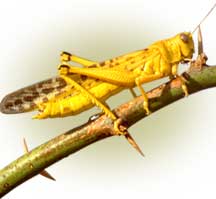How do insects breathe?
[ 2006-07-05 10:30 ]
昆蟲很容易被淹死�,這個大家都知道�。那昆蟲能不能被掐死呢?讀了下面這篇文章你就會知道了����。
 Insects breathe in a way that is very different
from us. Instead of having a central place to gather oxygen and a transport
system to deliver the oxygen to all of the cells of the body like us, insects
have a system of fine branching tubes called a tracheal system that delivers the
oxygen directly to each cell in the body. Insects breathe in a way that is very different
from us. Instead of having a central place to gather oxygen and a transport
system to deliver the oxygen to all of the cells of the body like us, insects
have a system of fine branching tubes called a tracheal system that delivers the
oxygen directly to each cell in the body.
When breathed in an insect, an
oxygen molecule in the atmosphere enters a tiny hole on the insect's thorax or
abdomen called a spiracle. The
spiracle is the opening of a long tube called tracheae. Then the oxygen molecule
proceeds down the tracheae, which is a long, air-filled, branching tube. It
continues to move through branches until reach a tiny, fluid-filled, dead
end called tracheole, and dissolve
in the fluid. From the fluid, it diffuses or moves across the wall of the
tracheole into an insect cell such as a muscle cell.
The movement of air
through the tracheal system of most
insects relies solely on diffusion.
Because most insects rely on diffusion, which occurs best over small distances,
they cannot get very large. You will not see huge ants, like in the movie
"Them," because enough air could not diffuse that far into their bodies to keep
their cells alive. However, some larger insects can use their abdominal muscles to force air in and out of the
tracheal system in a limited way.
So, with this system in mind, it would
be difficult to strangle a bug.
However, if the tracheal system fills with water, it takes much longer for air
to diffuse through the system. Therefore, an insect can drown fairly easily.
spiracle: 通氣孔
tracheole: [昆]微氣管
tracheal system: 氣管系統(tǒng)
diffusion: 擴散
abdominal: 腹部的
strangle: 扼死
(英語點津 Annabel
編輯)
|